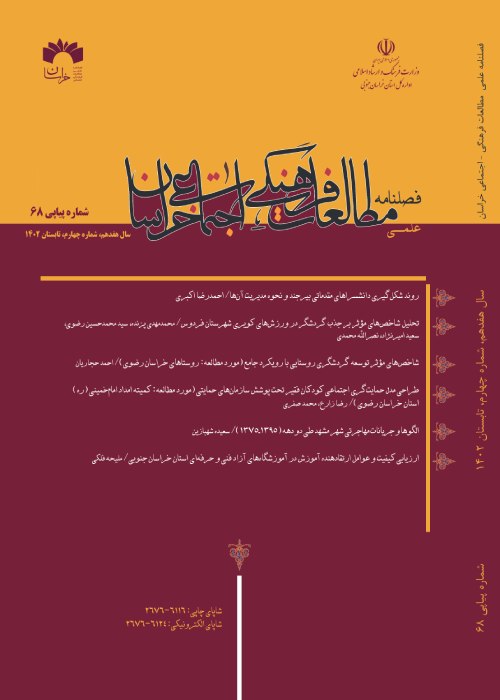The Role of Co-Creation in The Organizational Learning of Academic Staff Members of University of Birjand
Universities can implement the desired model of organizational learning if employees establish close, deep, interactive and cooperation with each other and adopt co-creation approaches (Zhang et al., 2011, p. 52). Co-creation supports the processes of change and group formation and enhances organizational learning by stimulating intellectual, collaborative and discursive, creative and innovative activities among employees and achieving a learning organization. In academic and university environments, faculty members with a co-creative approach can share the necessary information through mutual dialogue in a transparent environment, interact with each other, and improve their skills from organizational learning. Such learning is not only dependent on tools and techniques; rather, it is attained with support, insight and collective and meaningful participation (Mastio Chew & Dovey, 2019, p. 296). However, most of the studies related to organizational learning have not considered the factor that strengthens and even creates it, that is, co-creation. Therefore, in the present study, the researcher aimed to analyze the role of co-creation components on organizational learning among the faculty members of Birjand University and examined four sub-objectives. Therefore, the present study aims at:investigating the predictive role of dialogue on organizational learning among faculty members of University of Birjand. examining the predictive role of access on organizational learning among faculty members of University of Birjand. analyzing the predictive role of flexibility on organizational learning among faculty members of University of Birjand. scrutinizing the predictive role of transparency on organizational learning among faculty members of University of Birjand.
The current research is applied and descriptive in terms of purpose and method, and survey in terms of data collection. The statistical population of the study consisted of all 341 faculty members of University of Birjand. The population included five groups of humanities, basic sciences, engineering, agriculture and art, and each group was considered as a separate stratum by using a proportional stratified sampling method. The percentage of faculty members in each group was calculated about the total faculty members of Birjand University. In the final stage, the questionnaires were distributed among a proportion of faculty members in each group, which was estimated in relation to the total faculty members, and distributed randomly. Considering the size of the statistical population in the study (341 people) and considering that the minimum sample size is 200 in structural equation modeling, 210 questionnaires were distributed among the population and finally, 186 valid questionnaires were collected and analyzed. To measure the research variables, two questionnaires were used: a co-creation questionnaire (Taherpour, 2021) with a reliability coefficient of 0.91 and organizational learning questionnaire (Pham & Swireszek, 2006) with a reliability coefficient of 0.94. Data analysis was done by descriptive statistics and inferential statistics using SPSS software (version 23) and structural equation modeling was used to determine the relationship between co-creation and organizational learning.
First, Pearson’s correlation was used to examine the relationship between co-creation components and organizational learning. The results showed that all variables had a significant correlation with each other at the 0.01 level. The results also showed that co-creation predicted organizational learning. Co-creation had a positive and significant relationship with organizational learning at the 0.0001 level, with a standard coefficient of 0.78 and a t-statistic of 9.08. This means that on average, a one-unit increase or decrease in co-creation would lead to a 0.81-unit increase or decrease in organizational learning, respectively. Also, the fit of the research model was assessed by using the main absolute, parsimonious and comparative indices, which were all in an acceptable range. The normed fit index and the goodness of fit index (GFI) were both 0.94, the comparative fit index (CFI) was 0.94, and the root mean square error of approximation (RMSEA) was 0.09, which is close to zero. Therefore, the proposed model had a good fit.
The results indicated that there was a positive and significant relationship between co-creation and organizational learning of faculty members. Co-creation, by facilitating dialogue among faculty members, provided opportunities for sharing ideas and work experiences. Co-creation enabled employees to talk about their work experiences with colleagues, and thus, to share knowledge, information, plans and new ideas. This created a path to enhance and improve the organization and led to the generation of new knowledge and better and more learning in the organization. Co-creation also provided access to scientific information for faculty members, and thus, professors communicated with each other and created a field of knowledge and information sharing, which resulted in organizational learning. Co-creation ensured that faculty members provided information in an authentic, accurate, complete and clear manner to other colleagues, which increased organizational learning. Co-creation, by using the flexibility component, provided the field of constructive communication for faculty members to achieve organizational goals and to cooperate to learn more in their specialized field. In general, it can be concluded that co-creation created and improved organizational learning by providing the necessary conditions and factors such as access, transparency, dialogue and flexibility.
- حق عضویت دریافتی صرف حمایت از نشریات عضو و نگهداری، تکمیل و توسعه مگیران میشود.
- پرداخت حق اشتراک و دانلود مقالات اجازه بازنشر آن در سایر رسانههای چاپی و دیجیتال را به کاربر نمیدهد.



